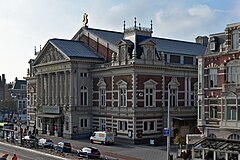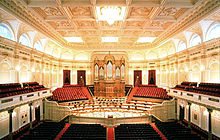Concertgebouw
| Royal Concertgebouw | |
|---|---|
| Koninklijk Concertgebouw | |
 | |
 Location in Amsterdam | |
| General information | |
| Status | Complete |
| Type | Concert hall |
| Architectural style | Neoclassical |
| Location | Museumplein |
| Address | Concertgebouwplein 10 1071 LN Amsterdam |
| Town or city | Amsterdam |
| Country | Netherlands |
| Coordinates | 52°21′22″N 4°52′46″E / 52.356223°N 4.879517°E / 52.356223; 4.879517Coordinates: 52°21′22″N 4°52′46″E / 52.356223°N 4.879517°E / 52.356223; 4.879517 |
| Current tenants | Royal Concertgebouw Orchestra |
| Construction started | 1883 |
| Completed | Late 1886 |
| Opened | 11 April 1888 |
| Renovated | July 1985 – April 1988 |
| Cost | 300,000 Dutch guilders |
| Owner | Het Concertgebouw N.V. (privately owned) |
| Design and construction | |
| Architect | Adolf Leonard van Gendt |
| Designations | Protected monument |
| Renovating team | |
| Architect | Pi de Bruijn |
| Other information | |
| Seating type | Theatre |
| Seating capacity | 1,974 (Main Hall) 437 (Recital Hall) 150 (Choir Hall)[1] |
| Website | |
| www.concertgebouw.nl | |
The Royal Concertgebouw (Dutch: Koninklijk Concertgebouw, pronounced [ˌkoːnɪnklək kɔnˈsɛrtxəbʌu]) is a concert hall in Amsterdam, Netherlands. The Dutch term "concertgebouw" literally translates into English as "concert building". On 11 April 2013, on occasion of the building's 125th anniversary, Queen Beatrix bestowed the Royal Title "Koninklijk" upon the building, as she did previously (in 1988) to the Royal Concertgebouw Orchestra.[2] Because of its highly regarded acoustics, the Concertgebouw is considered one of the finest concert halls in the world, along with places such as Boston's Symphony Hall[3][4] and the Musikverein in Vienna.[5]
Contents
1 History
2 Organ
3 Names of composers in the Main Hall
4 In popular culture
5 Gallery
6 See also
7 References
8 External links
History

The Concertgebouw in 1902
The architect of the building was Adolf Leonard van Gendt,[6] who was inspired by the Gewandhaus in Leipzig, built two years earlier (and destroyed in 1943).
Construction began in 1883 in a pasture that was then outside the city, in Nieuwer-Amstel, a municipality that in 1964 became Amstelveen.[7] A total of 2,186 piles of length twelve to thirteen metres (40 to 43 ft) were sunk into the soil.[8] The Concertgebouw was completed in late 1886, however due to the difficulties with the municipality of Nieuwer-Amstel - filling in a small canal, paving the access roads and installing street lights - the grand opening of the building was waiting.[9]
The hall opened on 11 April 1888 with an inaugural concert, in which an orchestra of 120 musicians and a chorus of 500 singers participated, performing works of Wagner, Handel, Bach, and Beethoven. The resident orchestra of the Concertgebouw is the Royal Concertgebouw Orchestra (Koninklijk Concertgebouworkest), which gave its first concert in the hall on 3 November 1888, as the Concertgebouw Orchestra (Concertgebouworkest). For many decades the Netherlands Philharmonic Orchestra and the Radio Filharmonisch Orkest have also been regular performers in the Concertgebouw.[citation needed]

The Main Hall (Grote Zaal) of the Concertgebouw
The Main Hall (Grote Zaal) seats 1,974,[1] and is 44 metres (144 ft) long, 28 metres (92 ft) wide, and 17 metres (56 ft) high.[10] Its reverberation time is 2.8 seconds without audience, 2.2 seconds with, making it ideal for the late Romantic repertoire such as Mahler. Although this characteristic makes it largely unsuited for amplified music, groups such as Led Zeppelin, Pink Floyd and The Who did perform there in the 1960s. It hosts not only orchestral and operatic performances, but also jazz and world music.[citation needed]
A smaller, oval-shaped venue, the Recital Hall (Kleine Zaal), is located behind the Main Hall. The Recital Hall is 20 metres (66 ft) long and 15 metres (50 ft) wide.[10] Its more intimate space is well-suited for chamber music and Lieder. The Recital Hall has 437 seats.[1]
When the Concertgebouw was built, acoustics were something of a black art. As in shipbuilding, designers drew upon what had worked in the past without entirely understanding the underlying science. When the building was completed, the acoustics were not perfect, and a lot of effort went into fine-tuning the aural ambience. During later restorations, particular care has been taken not to alter the materials used for interior decoration with this in mind.
In 1983, the Concertgebouw was found to be sinking into the damp Amsterdam earth, with several inch-wide cracks appearing in the walls, so the hall embarked on extensive fundraising for renovations. Its difficult emergency restoration started in 1985, during which the 2,186 rotting wooden pilings were replaced with concrete pillars. Pi de Bruijn, Dutch architect designed a modern annex for a new entrance and a basement to replace cramped dressing and rehearsal space.[11]

The Concertgebouw's east side before its restoration in 1985.

The Concertgebouw's east side with the new entrance.

The new gilded lyre on top of Concertgebouw
Today, some nine hundred concerts and other events per year take place in the Concertgebouw, for a public of over 700,000, making it one of the most-visited concert halls in the world.[12]
As of February 2014[update], the managing director of the Concertgebouw is Simon Reinink and the artistic director is Anneke Hogenstijn.[13]
Organ

The organ in the Main Hall of the Concertgebouw
The organ was built in 1890 by the organ builder Michael Maarschalkerweerd from Utrecht, and was renovated in the years 1990 to 1993 by the organ builder Flentrop. It has 60 registers on three divisions and pedal.[14]
|
|
|
| ||||||||||||||||||||||||||||||||||||||||||||||||||||||||||||||||||||||||||||||||||||||||||||||||||||||||||||||||||||||||||||||
- Couplers: II/I (also as Suboktavkoppel), III/I, III/II, I/P, II/P, III/P
Names of composers in the Main Hall
In the Main Hall, the surnames of the following 46 composers are displayed on the balcony ledges and on the walls:[15]
|
|
|
|
In popular culture
The Concertgebouw is mentioned, along with Madison Square Garden, the Hollywood Bowl, and the Rainbow Theatre, in the song "Rock Show" from the 1975 Wings album Venus and Mars.[16]
Kris de Bruyne, a Belgian singer, mentions the Concertgebouw in his song "Amsterdam".[17]
Errol Garner recorded the live Album The Amsterdam Concert in the venue in November 1964.[18]
Gallery

Architectural drawings of the design, dated 1888

The Concertgebouw at night, 2008

A piano quintet concert in the Main Hall, July 2010
See also
- Royal Concertgebouw Orchestra
- History of Amsterdam
- List of concert halls
- List of tourist attractions in Amsterdam
References
^ abc "Concert halls". Concertgebouw NV. Retrieved 24 February 2014..mw-parser-output cite.citation{font-style:inherit}.mw-parser-output q{quotes:"""""""'""'"}.mw-parser-output code.cs1-code{color:inherit;background:inherit;border:inherit;padding:inherit}.mw-parser-output .cs1-lock-free a{background:url("//upload.wikimedia.org/wikipedia/commons/thumb/6/65/Lock-green.svg/9px-Lock-green.svg.png")no-repeat;background-position:right .1em center}.mw-parser-output .cs1-lock-limited a,.mw-parser-output .cs1-lock-registration a{background:url("//upload.wikimedia.org/wikipedia/commons/thumb/d/d6/Lock-gray-alt-2.svg/9px-Lock-gray-alt-2.svg.png")no-repeat;background-position:right .1em center}.mw-parser-output .cs1-lock-subscription a{background:url("//upload.wikimedia.org/wikipedia/commons/thumb/a/aa/Lock-red-alt-2.svg/9px-Lock-red-alt-2.svg.png")no-repeat;background-position:right .1em center}.mw-parser-output .cs1-subscription,.mw-parser-output .cs1-registration{color:#555}.mw-parser-output .cs1-subscription span,.mw-parser-output .cs1-registration span{border-bottom:1px dotted;cursor:help}.mw-parser-output .cs1-hidden-error{display:none;font-size:100%}.mw-parser-output .cs1-visible-error{font-size:100%}.mw-parser-output .cs1-subscription,.mw-parser-output .cs1-registration,.mw-parser-output .cs1-format{font-size:95%}.mw-parser-output .cs1-kern-left,.mw-parser-output .cs1-kern-wl-left{padding-left:0.2em}.mw-parser-output .cs1-kern-right,.mw-parser-output .cs1-kern-wl-right{padding-right:0.2em}
^ "Koninklijke status voor Het Concertgebouw". Concertgebouw NV. Retrieved 11 April 2013.
^ April 11, 1888: Concertgebouw, Home of Nearly Perfect Acoustics, Opens
^ R.W. Apple, Jr., Apple's America (North Point Press, 2005),
ISBN 0-86547-685-3.
^ Tapio Lahti and Henrik Möller. "Concert Hall Acoustics and the Computer". ARK – The Finnish Architectural Review. Archived from the original on 2007-03-22.
^ "Concertgebouw (rijksmonument #288)". Monumentenregister (in Dutch). Rijksdienst voor het Cultureel Erfgoed. Retrieved 9 February 2012.
^ Drawing of the Concertgebouw in the fields[permanent dead link], at the Amsterdam City Archives
^ Paul L. Montgomery (13 April 1988). "Dutch Hail Concertgebouw's 100th". New York Times. Retrieved 12 October 2007.
^ "History of the building". Official website of the Concertgebouw. Retrieved 2018-06-10.
^ ab "Het Concertgebouw – Capaciteit Zalen" (PDF). Concertgebouw NV. Archived from the original (PDF) on 26 November 2013. Retrieved 24 February 2014.
^ Paul L. Montgomery (13 April 1988). "Dutch Hail Concertgebouw's 100th". New York Times. Retrieved 12 October 2007.
^ "Facts & Figures". Concertgebouw NV. Retrieved 24 February 2014.
^ "Jaarverslag 2012" [Annual Report 2012] (PDF) (in Dutch). Concertgebouw NV. 2013-04-02. Archived from the original (PDF) on 7 February 2014. Retrieved 24 February 2014.
^ Information on Organ (PDF)
^ "Reader De eregalerijen in het concertgebouw" (PDF). Vrienden Concertgebouw & Koninklijk Concertgebouworkest. Retrieved 23 February 2014.
^ Guarisco, D.A. "Venus and Mars/Rock Show". Allmusic. Retrieved 13 October 2011.
^ "Kris De Bruyne - Meisje In Het Blauw Testo Canzone". Lyrics MTV (in Italian). Viacom. 16 October 2006. Retrieved 9 April 2018.
^ Errol Garner
External links
| Dutch Rijksmonument 288 |
 Media related to Concertgebouw, Amsterdam at Wikimedia Commons
Media related to Concertgebouw, Amsterdam at Wikimedia Commons- Official website
Archive of the Concertgebouw[permanent dead link] at the Amsterdam City Archives
"History of the building". Official website of the Concertgebouw.





